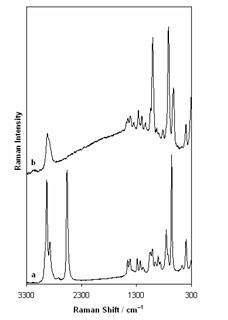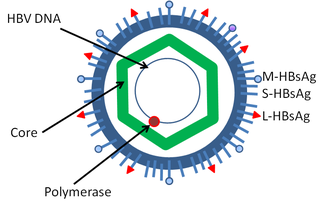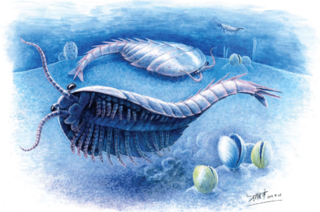Related Research Articles

Digital microfluidics (DMF) is a platform for lab-on-a-chip systems that is based upon the manipulation of microdroplets. Droplets are dispensed, moved, stored, mixed, reacted, or analyzed on a platform with a set of insulated electrodes. Digital microfluidics can be used together with analytical analysis procedures such as mass spectrometry, colorimetry, electrochemical, and electrochemiluminescense.

An immunoassay (IA) is a biochemical test that measures the presence or concentration of a macromolecule or a small molecule in a solution through the use of an antibody (usually) or an antigen (sometimes). The molecule detected by the immunoassay is often referred to as an "analyte" and is in many cases a protein, although it may be other kinds of molecules, of different sizes and types, as long as the proper antibodies that have the required properties for the assay are developed. Analytes in biological liquids such as serum or urine are frequently measured using immunoassays for medical and research purposes.

Duke Wen of Jin, born Chong'er, was a scion of the royal house of Jin during the Spring and Autumn Period of Chinese history. He famously endured a long period of exile from his realm before finally being restored to power and rapidly leading Jin to hegemony over the other Chinese states of his time. He is a figure in numerous Chinese legends, including those about his loyal courtier Jie Zhitui, whose death is said to have inspired China's Cold Food and Qingming Festivals.

The hook effect refers to the prozone phenomenon, also known as antibody excess or the Postzone phenomenon, also known as antigen excess. It is an immunologic phenomenon whereby the effectiveness of antibodies to form immune complexes is can be impaired when concentrations of an antibody or an antigen are very high. The formation of immune complexes stops increasing with greater concentrations and then decreases at extremely high concentrations, producing a hook shape on a graph of measurements. An important practical relevance of the phenomenon is as a type of interference that plagues certain immunoassays and nephelometric assays, resulting in false negatives or inaccurately low results. Other common forms of interference include antibody interference, cross-reactivity and signal interference. The phenomenon is caused by very high concentrations of a particular analyte or antibody and is most prevalent in one-step (sandwich) immunoassays.

17α-Hydroxyprogesterone (17α-OHP), also known as 17-OH progesterone (17-OHP), or hydroxyprogesterone (OHP), is an endogenous progestogen steroid hormone related to progesterone. It is also a chemical intermediate in the biosynthesis of many other endogenous steroids, including androgens, estrogens, glucocorticoids, and mineralocorticoids, as well as neurosteroids.
Enzyme multiplied immunoassay technique (EMIT) is a common method for qualitative and quantitative determination of therapeutic and recreational drugs and certain proteins in serum and urine.

Surface-enhanced Raman spectroscopy or surface-enhanced Raman scattering (SERS) is a surface-sensitive technique that enhances Raman scattering by molecules adsorbed on rough metal surfaces or by nanostructures such as plasmonic-magnetic silica nanotubes. The enhancement factor can be as much as 1010 to 1011, which means the technique may detect single molecules.

The enzyme horseradish peroxidase (HRP), found in the roots of horseradish, is used extensively in biochemistry applications. It is a metalloenzyme with many isoforms, of which the most studied type is C. It catalyzes the oxidation of various organic substrates by hydrogen peroxide.
Blood stasis (BS) is a concept in traditional Chinese medicine (TCM), described as a slowing or pooling of the blood due to a disruption of heart qi. Blood stasis is also described by practitioners of TCM in terms of yin deficiency, qi deficiency and qi stagnation. For non-practitioners of TCM it is sometimes explained in terms of hematological disorders such as hemorrhage, congestion, thrombosis or local ischemia, and in terms of tissue changes. TCM practitioners believe it is an important underlying pathology of many disease processes despite the fact that objective, consistent methods for measuring the presence of blood stasis syndrome are not readily available. Blood stasis is associated with justifications for acupuncture and herbal treatments.

(S)-Canadine, also known as (S)-tetrahydroberberine and xanthopuccine, is a benzylisoquinoline alkaloid (BIA), of the protoberberine structural subgroup, and is present in many plants from the family Papaveraceae, such as Corydalis yanhusuo and C. turtschaninovii.

HBcAg is a hepatitis B viral protein. It is an indicator of active viral replication; this means the person infected with Hepatitis B can likely transmit the virus on to another person.
Gargela is a genus of moths in the subfamily Crambinae of the family Crambidae. The genus currently comprises 22 Austral-Asian species, of which the majority has been described in recent years. Many species remain to be described, with their total number probably being around 40 species.

Coreinae is a subfamily in the hemipteran family Coreidae. They have been shown to be paraphyletic with respect to Meropachyinae.

Apache SINGA is an Apache top-level project for developing an open source machine learning library. It provides a flexible architecture for scalable distributed training, is extensible to run over a wide range of hardware, and has a focus on health-care applications.

21-Deoxycortisol, also known as 11β,17α-dihydroxyprogesterone or as 11β,17α-dihydroxypregn-4-ene-3,20-dione, is a naturally occurring, endogenous steroid related to cortisol (11β,17α,21-trihydroxyprogesterone) which is formed as a metabolite from 17α-hydroxyprogesterone via 11β-hydroxylase.
Chen Tang Jie is a Malaysian badminton player. He was part of the Malaysian 2016 Asian Junior Championships and 2016 BWF World Junior Championships team, and has help Malaysia to clinched a silver medal in the World Junior mixed team before defeated by China.

Chen Ming-jer is a Taiwanese business and management academic. He is the Leslie E. Grayson Professor of Business Administration at University of Virginia Darden School of Business.

Fuxianhuiida is an extinct clade of arthropods from the Cambrian of China. All currently known species are from Cambrian Series 2 aged deposits in Yunnan Province, including the Chengjiang biota. They are generally considered to be close to the base of Euarthropoda, but have also been considered to be early mandibulates. Many specimens are known with exceptional soft tissue preservation, including preserved guts and neural tissue, which given their basal phylogenetic position makes them important in understanding the evolution of arthropoda as a whole. They reach a size of up to 15 cm, and are interpreted as benthic predators and scavengers. The fuxianhuiid exoskeleton is unmineralised, and the number of tergites ranges from 15 to over 40. The cephalon is covered by a head shield and contains stalked eyes connected by the anterior sclerite, antennae, a butterfly shaped hyposome and a posterior facing mouth. Fuxianhuiids possess specialized post-antennal appendages with serrated edges used for food processing. The presence of gnathobases in members of Chengjiangocardidae suggests that they were capable of durophagy. In most fuxianhuiids, the thorax tergites narrow posteriorly, terminating in either a swimming paddle or paired flukes with a tailspine. In members of Fuxianhuiidae the thorax is divided into two sections, the anterior wide opisthothorax and the posterior narrow limbless tail-like abdomen.
Praseodymium(III) fluoride is an inorganic compound with the formula PrF3, being the most stable fluoride of praseodymium.

HC-067047 is a drug which acts as a potent and selective antagonist for the TRPV4 receptor. It has been used to investigate the role of TRPV4 receptors in a number of areas, such as regulation of blood pressure, bladder function and some forms of pain, as well as neurological functions.
References
- ↑ Wang, Chen; Wu, Jie; Zong, Chen; Xu, Jie; Ju, Huang-Xian (January 2012). "Chemiluminescent Immunoassay and its Applications". Chinese Journal of Analytical Chemistry. 40 (1): 3–10. doi:10.1016/S1872-2040(11)60518-5. ISSN 1872-2040.
- ↑ Cinquanta L, Fontana DE, Bizzaro N (December 2017). "Chemiluminescent immunoassay technology: what does it change in autoantibody detection?". Auto Immun Highlights. 8 (1): 9. doi:10.1007/s13317-017-0097-2. PMC 5483212 . PMID 28647912.